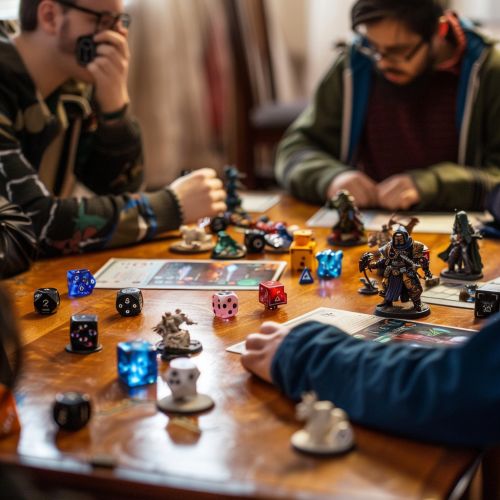Tabletop RPG Development
Introduction
Tabletop RPG (Role-Playing Game) development refers to the process of designing, creating, and refining a game system that is played in a social setting with the use of physical components such as dice, miniatures, and character sheets. It involves a combination of game design, narrative development, and system mechanics. The development process can vary greatly depending on the complexity of the game, the size of the development team, and the intended audience. Game design principles, narrative structures, and probability theory are often employed in the creation of a tabletop RPG.


History
The history of tabletop RPG development can be traced back to the mid-20th century, with the advent of wargaming. Wargaming is a type of game that simulates warfare scenarios, and it served as a precursor to modern tabletop RPGs. The first widely recognized tabletop RPG, Dungeons & Dragons (D&D), was published in 1974 by Tactical Studies Rules, Inc. (TSR). D&D introduced a new form of gameplay that combined elements of traditional wargaming with aspects of fantasy literature and role-playing.
Game Design
The game design of a tabletop RPG involves creating the rules and systems that govern gameplay. This includes the mechanics for character creation, combat, skill use, and progression. The goal of game design in a tabletop RPG is to create a balanced and engaging experience for all players.
Mechanics
Mechanics are the rules and procedures that guide the gameplay. They define the way the game world operates and how the players interact with it. Mechanics can include systems for character creation, combat, skill use, magic, and more. The mechanics of a game should support the overall theme and narrative of the RPG.
Balance
Balance in a tabletop RPG refers to the fairness and equality of the game mechanics. A balanced game ensures that no character or strategy is overwhelmingly powerful or weak. This is achieved through careful design and testing of the game mechanics.
Engagement
Engagement in a tabletop RPG is achieved through compelling gameplay and narrative. A well-designed game will keep players interested and invested in the game world and their characters. This can be achieved through a combination of interesting mechanics, a compelling setting, and a strong narrative.
Narrative Development
Narrative development in a tabletop RPG involves creating the setting, plot, and characters that make up the game world. This narrative serves as the backdrop for the players' adventures and can greatly enhance the overall gaming experience.
Setting
The setting of a tabletop RPG is the world in which the game takes place. This can range from a fantasy world filled with magic and mythical creatures, to a futuristic sci-fi universe, to a historical period on Earth. The setting informs the narrative and mechanics of the game, and provides a context for the players' actions.
Plot
The plot of a tabletop RPG is the overarching story that guides the players' adventures. This can be a pre-written adventure created by the game designer, or a dynamic story that evolves based on the players' actions. The plot provides structure and direction for the game.
Characters
Characters in a tabletop RPG are the personas that the players assume during gameplay. Character creation involves defining a character's abilities, skills, backstory, and motivations. Characters are the primary way that players interact with the game world and the narrative.
System Mechanics
The system mechanics of a tabletop RPG are the rules and procedures that govern gameplay. This includes the mechanics for character creation, combat, skill use, and progression. The system mechanics should support the overall theme and narrative of the RPG.
Character Creation
Character creation is the process by which players create their characters for the game. This usually involves choosing a race, class, and abilities for the character, as well as defining their backstory and motivations. Character creation is a key part of the RPG experience, as it allows players to create a unique persona to navigate the game world.
Combat
Combat in a tabletop RPG is typically governed by a set of rules that determine how characters fight and take damage. This can involve rolling dice to determine the success of attacks, calculating damage, and managing character health. Combat mechanics should be balanced and engaging, providing a challenge for players while keeping gameplay fair and fun.
Skill Use
Skill use in a tabletop RPG involves characters using their abilities to overcome challenges. This can include everything from picking locks to persuading NPCs (Non-Player Characters) to casting spells. Skill use is typically governed by a set of rules that determine the success and effects of these actions.
Progression
Progression in a tabletop RPG involves characters growing and developing over time. This can involve gaining experience points, leveling up, and acquiring new abilities and equipment. Progression mechanics should provide a sense of achievement and growth, encouraging players to continue playing and exploring the game world.
Conclusion
Tabletop RPG development is a complex process that involves a blend of game design, narrative development, and system mechanics. The goal of the development process is to create a balanced and engaging game that provides a compelling experience for players. With careful design and thoughtful consideration of the game's mechanics, narrative, and setting, a tabletop RPG can provide countless hours of immersive, social, and imaginative gameplay.
See Also
Role-Playing Game Theory Game Balance Interactive Storytelling Game Testing
